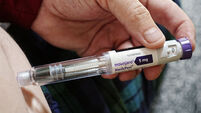More training required after baby’s death, says inquest

The death of a baby 34 minutes after birth in Cork University Maternity Hospital (CUMH) has prompted recommendations for improved training on an emergency beeper system.
Baby Tom Luke Moynihan died from a lack of oxygen due to placental vasa previa, a rare but potentially fatal condition that impacts one in 3,000 pregnancies.
A jury of five women and one man called for additional training to be provided on an emergency call system and for receptionists to be included in training and drills in future.
Concerns had been raised that a consultant was not automatically included on the beeper system.
A verdict of death by natural causes was delivered after a two-day inquest in Cork Coroner’s court in front of Coroner Philip Comyn.
The Moynihans are “happy that the process is over,” their barrister, Roger Murray, SC, partner and head of the clinical negligence unit of Callan Tansey Solicitors, said following the verdict.
“They hope the recommendations will improve patient outcomes,” he said.
Baby Tom Luke died 34 minutes after delivery by emergency caesarean section at 36 weeks and two days gestation. He had been born “extremely pale” and his heartbeat was not detected after he was delivered at 6.43pm on May 27, 2016.
His mother, Lisa Moynihan, had noticed blood running down her legs and found herself standing in a pool of blood while at work following a substantial, painless, unprovoked antepartum haemorrhage.
She was brought to CUMH by ambulance where an emergency caesarean section was performed as her baby’s heartbeat had dropped dangerously low. But despite efforts to resuscitate the baby, he was pronounced dead at 7.17pm.
Cork Coroners court heard that baby Tom Luke’s resuscitation had been sub-optimal.
Pathologist Dr Brendan Fitzgerald gave the cause of death as acute hypoxia/ischemia (lack of oxygen), principally as a result of the effects of placental vasa previa.
In vasa praevia, some fetal umbilical cord blood vessels run across or very close to the internal opening of the cervix. These vessels are unprotected by the umbilical cord or the placenta and are therefore at risk of rupturing when the membranes break.
If the membranes tear during labour, the blood vessels might also tear with the baby potentially losing a life-threatening amount of blood.
It is also possible that when the baby drops into the pelvis, the vessels may be compressed, affecting its blood supply and causing oxygen deprivation.
A low-lying placenta is one of the risks for this condition. But none of the risk factors for vasa pravia were present in Lisa Moynihan’s pregnancy before her sudden and severe blood loss.
The mortality rate for undiagnosed vasa pravia is 50%, and studies have shown vasa praevia in one in 3,000 pregnancies.
“I can’t find any evidence of a baby who passed away from vasa praevia since 2016, it’s very rare,” Dr Mairead O’Riordan, consultant obstetrician/gynaecologist at CUMH said.
Mrs Moynihan’s pregnancy had been uncomplicated, Dr O’Riordan said. She was 33 at the time, it was her first pregnancy. Everything was going well until May 27, 2016 when she suffered severe blood loss at work and was taken by ambulance to CUMH.
Dr O’Riordan said that the hospital operates an emergency and a routine beeper system.
The hospital decided that it was not appropriate for a consultant to always be on the crash or emergency beeper system as they may have gone home and other qualified staff would be on hand. But she said that consultant’s telephone numbers were listed by the telephones and they could be called by staff in an emergency.
It took some 22 minutes to get blood to a severely anaemic baby Tom Luke after birth.
Blood is kept in the blood bank, not on site in the CUMH theatres. Dr O’Riordan said that storage of the blood is kept under constant review, and it is the subject of a current review as CUH is becoming a major trauma centre. She said that it takes four minutes to transport the blood from the blood bank in CUH to theatre in CUMH.
“We decided the blood bank was the safest place for blood to be maintained. This is under current review again.
“The reason we haven’t brought a blood fridge into the maternity hospital is because of concerns quality could not be maintained."
“We would use 1/3 of blood in the hospital system, we have a lot of engagement with them. And we have to use it in a hurry.
But Mr Murray noted that it was “a matter of serious concern to family that the blood took so long to be given.” He said that he was aware of other hospitals where blood was kept on site.
Dr O’Riordan agreed that there were quicker systems but these may not be better.
“We put a lot of thought into this. We try to provide the best service to patients. And the quickest is not always the best,” she said.
She agreed that a review of baby Tom Luke’s care had “slipped through the cracks”.
The hospital moved from CUH to independent status as CUMH in 2017 and processes have since changed.
She said that she did review baby Tom Luke’s care at the time, particularly looking at timings and decisions on procedures.
But Mr Murray noted that there was no formal written review.
Although that process has now changed, and obstetric and neonatal teams now meet and review deaths of babies together and provide reports, “what happens now regarding reviews is of scant consolation” to the parents, Mr Murray said.
“It took six and a half years for the family to find out what happened in that review — and they found that it did not happen,” Mr Murray said.
“They were promised a review and it didn’t happen.
“The absence of a formal written review is the absence of institutional memory.”
Eamon Harrington, partner at Comyn, Kelleher, Tobin solicitors acting for CUMH extended sympathies to the family for their loss, and to staff who had also found baby Tom Luke’s death difficult and distressing.















